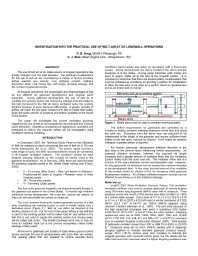Mining Publication: Investigation into the Practical Use of Belt Air at US Longwall Operations
Original creation date: February 2009
The use of belt air as an intake source at longwall operations has greatly changed over the past decades. The practical considerations for the use of belt air are controlled by a variety of factors including airflow quantity and velocity, coal methane content, methane desorption rates, coal mining rate, belt length, stopping leakage, and the number of gateroad entries. At longwall operations, the advantages and disadvantages of belt air are different for gateroad development and longwall panel extraction. During gateroad development, the use of belt air to ventilate the working section will reduce the leakage from the intake to the belt compared to the belt air being ventilated outby the working sections because of lower pressure differentials. A greater quantity of airflow will reach the last open crosscut with belt on intake than outby, given the same amount of pressure and airflow available at the mouth of the section. This paper will investigate the current ventilation practices regarding the use of belt air during gateroad development and longwall panel extraction. Operating considerations regarding air quantities and pressures to deliver the required airflow will be investigated using ventilation network modeling.
Authors: RB Krog, CJ Bise
Conference Paper - February 2009
NIOSHTIC2 Number: 20035076
2009 SME Annual Meeting and Exhibit, February 22-25, Denver, Colorado, preprint 09-105. Littleton, CO: Society for Mining, Metallurgy, and Exploration, Inc., 2009; :1-5
See Also
- CO and CO2 Emissions from Spontaneous Heating of Coal Under Different Ventilation Rates
- Dust Considerations When Using Belt Entry Air to Ventilate Work Areas
- Experimental and Modeling Investigation of the Effect of Ventilation on Smoke Rollback in a Mine Entry
- Field Study of Longwall Coal Mine Ventilation and Bleeder Performance
- Modeling and Prediction of Ventilation Methane Emissions of U.S. Longwall Mines Using Supervised Artificial Neural Networks
- A New Methane Control and Prediction Software Suite for Longwall Mines
- Novel Stopping Designs for Large-Opening Metal/Nonmetal Mines
- Technology News 519 - EZ-Up Curtain Stoppings: A Practical Solution for Directing Ventilation Airflows in Large-opening Metal/Nonmetal Mines
- Tracer Gas as an Aid in Mine Ventilation Analysis
- Using Ultrasonic Anemometers to Evaluate Face Ventilation Conditions
- Page last reviewed: 5/1/2017
- Page last updated: 9/21/2012
- Content source: National Institute for Occupational Safety and Health, Mining Program


 ShareCompartir
ShareCompartir
